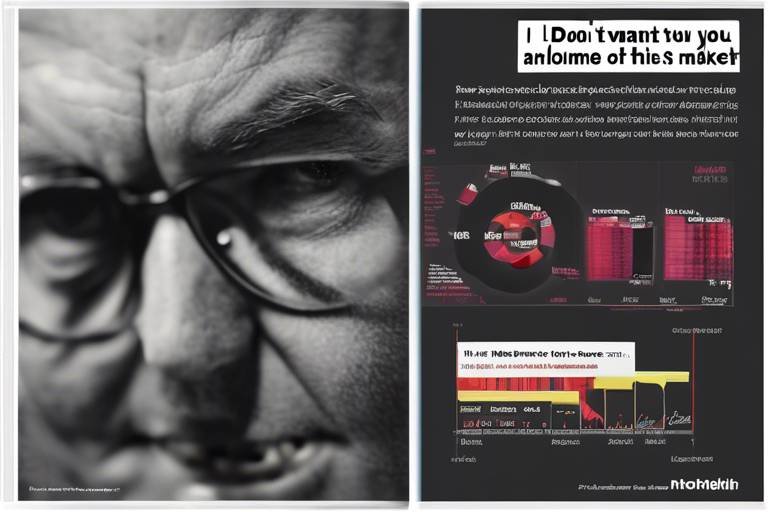Understanding Market Signals - Reading the Crypto Landscape
In the ever-evolving world of cryptocurrency, understanding market signals is akin to having a compass in a dense forest. The landscape is riddled with uncertainty and rapid changes, making it essential for traders and investors to decode the signals that indicate where the market is headed. These signals can be the difference between riding a wave of success or crashing into the rocks of financial loss. So, how do you read these signals effectively?
Market signals are indicators that provide insights into the direction and strength of market trends. They help you make informed decisions in a fast-paced environment where every second counts. Imagine you're on a road trip without a GPS; you'd be lost without directions. Similarly, market signals guide you through the tumultuous waters of cryptocurrency trading, allowing you to spot opportunities and avoid pitfalls.
Understanding market signals is crucial for anyone looking to navigate the crypto landscape effectively. Whether you're a seasoned trader or a newcomer, grasping these concepts can empower you to make strategic decisions that align with your investment goals. Instead of diving headfirst into trades, you can take a step back, analyze the signals, and act wisely. But what exactly are these signals?
Market signals refer to various indicators that help traders and investors gauge the direction and strength of market trends. They can be broadly categorized into three main types: technical indicators, fundamental analysis, and sentiment analysis. Each of these categories offers unique insights that can significantly impact your trading strategy.
Let's delve deeper into the types of market signals and how they can be utilized. Understanding these signals is like having a toolkit at your disposal; the more tools you have, the better equipped you are to tackle challenges and seize opportunities.
Technical indicators are mathematical calculations based on historical price and volume data. They serve as vital tools for traders, helping them identify potential entry and exit points in the market. By analyzing these indicators, you can enhance your decision-making process and improve your chances of success.
One of the most commonly used technical indicators is the moving average. This tool smooths out price data to help identify trends over a specific period. Think of it as a weather forecast; just as you rely on forecasts to prepare for rain or shine, moving averages help you determine market direction. They can signal potential reversals or continuations, providing you with the foresight needed to make informed decisions.
Another essential tool is the Relative Strength Index (RSI). This indicator measures the speed and change of price movements, helping traders identify overbought or oversold conditions. Imagine you're at a party, and you notice that everyone is either dancing wildly or sitting quietly. The RSI helps you gauge whether the market is overreacting, providing valuable insights into potential corrections.
On the other hand, fundamental analysis involves evaluating a cryptocurrency's underlying value. This analysis considers various factors such as technology, the team behind the project, market demand, and competition. By examining these elements, you can assess a cryptocurrency's long-term potential beyond the noise of short-term price fluctuations.
Sentiment analysis is another crucial aspect of understanding market signals. It gauges market sentiment through social media, news, and community discussions. By understanding public perception, traders can anticipate market movements and adjust their strategies accordingly. It's like reading the room before making a big announcement; knowing how people feel can significantly impact the outcome.
Monitoring social media trends is vital for capturing real-time sentiment and reactions to market events. Platforms like Twitter and Reddit can be goldmines of information. Traders who tap into these trends can make timely investment decisions, riding the wave of public enthusiasm or pulling back when negativity looms.
News events can significantly influence market behavior. Analyzing how news affects sentiment can prepare traders for potential market volatility. Just like a sudden storm can change your travel plans, unexpected news can shift market dynamics. By staying informed, you can capitalize on emerging opportunities or protect your investments from downturns.
- What are market signals? Market signals are indicators that help gauge the direction and strength of market trends.
- How do technical indicators work? They use historical price and volume data to identify potential entry and exit points.
- What is the importance of fundamental analysis? It helps assess a cryptocurrency's long-term potential, beyond short-term price changes.
- How can sentiment analysis impact trading? Understanding market sentiment can help anticipate movements and adjust strategies accordingly.

What Are Market Signals?
Market signals are like the whispers of the financial world, guiding traders and investors through the often tumultuous waters of the cryptocurrency landscape. Imagine you're navigating a vast ocean; without a compass or stars to guide you, you could easily drift off course. Similarly, market signals help you pinpoint where the market is heading, allowing you to make informed decisions rather than relying on guesswork. These signals can come in various forms, each providing unique insights that can dramatically affect your trading strategy.
In the cryptocurrency sector, where volatility is the name of the game, understanding market signals is crucial. They serve as indicators that reveal the direction and strength of market trends. Whether you're a seasoned trader or a newcomer, recognizing these signals can be the difference between profit and loss. Think of market signals as your personal radar, helping you detect opportunities and avoid potential pitfalls.
Market signals can be broadly categorized into three main types: technical indicators, fundamental analysis, and sentiment analysis. Each type plays a vital role in shaping your investment decisions. Here’s a quick breakdown:
| Type of Market Signal | Description |
|---|---|
| Technical Indicators | Mathematical calculations based on historical price and volume data. |
| Fundamental Analysis | Evaluating the underlying value of a cryptocurrency. |
| Sentiment Analysis | Assessing market sentiment through social media and news. |
Understanding these signals can provide you with a competitive edge. For instance, technical indicators can help you identify potential entry and exit points, while fundamental analysis allows you to gauge the long-term viability of a cryptocurrency. On the other hand, sentiment analysis can give you a feel for the market's mood, helping you anticipate shifts before they happen.
In summary, market signals are essential tools that can help you navigate the complex and often unpredictable world of cryptocurrency trading. By learning to read these signals, you can make more informed decisions, minimize risks, and potentially maximize your returns. So, whether you're looking to make a quick profit or invest for the long term, keeping an eye on market signals is undoubtedly a savvy strategy.

Types of Market Signals
When it comes to navigating the unpredictable waters of the cryptocurrency market, understanding the is essential. These signals act as your compass, guiding you through the tumultuous landscape of digital currencies. They can be broadly categorized into three primary types: technical indicators, fundamental analysis, and sentiment analysis. Each type brings its own unique flavor to the table, offering insights that can help you make informed investment decisions.
Technical indicators are like the weather forecasts of the trading world. They rely on mathematical calculations derived from historical price and volume data to help traders identify potential entry and exit points. Imagine a sailor using weather patterns to decide the best time to set sail; similarly, traders use these indicators to navigate their trading journeys. Some popular technical indicators include:
- Moving Averages: These indicators smooth out price data to reveal trends over specific periods. They act like a trail of breadcrumbs, leading you to potential market directions and signaling possible reversals or continuations.
- Relative Strength Index (RSI): The RSI measures the speed and change of price movements, helping traders identify whether a cryptocurrency is overbought or oversold. Think of it as a temperature gauge for market conditions, indicating when it might be time to cool off or heat up your investments.
On the other hand, fundamental analysis digs deeper into the essence of a cryptocurrency. This approach evaluates the underlying value of a digital asset by examining factors such as technology, the strength of the development team, market demand, and competition. It’s like peering beneath the surface of a beautiful ocean to understand the coral reefs and marine life that sustain it. By focusing on these fundamentals, investors can assess a cryptocurrency's long-term potential rather than getting swept away by short-term price fluctuations.
Last but not least, we have sentiment analysis. This type of signal is akin to taking the market's pulse. It gauges public sentiment through various channels, including social media, news outlets, and community discussions. Understanding how the crowd feels can provide valuable insights into potential market movements. For instance, a sudden surge in positive sentiment on platforms like Twitter or Reddit can indicate an impending price rally, while negative news might prompt a sell-off.
To illustrate the interplay between these signals, consider the following table:
| Type of Market Signal | Description | Key Indicators |
|---|---|---|
| Technical Indicators | Mathematical calculations based on historical data to identify trends. | Moving Averages, RSI |
| Fundamental Analysis | Evaluation of a cryptocurrency's intrinsic value and potential. | Technology, Team Strength, Market Demand |
| Sentiment Analysis | Assessment of public perception and mood regarding the market. | Social Media Trends, News Impact |
In conclusion, each type of market signal offers a different lens through which to view the cryptocurrency landscape. By combining these insights, traders and investors can better navigate the complexities of the market, making decisions that are not just informed but also strategically sound. Whether you’re a seasoned trader or a newbie, understanding these signals can be your key to unlocking the mysteries of crypto trading.

Technical Indicators
When diving into the world of cryptocurrency trading, are your compass. They are like the GPS of the trading landscape, guiding you through the often turbulent waters of price movements and market trends. But what exactly are these indicators? In essence, they are mathematical computations that derive insights from historical price and volume data. By analyzing these patterns, traders can spot potential entry and exit points, which is crucial for maximizing profits and minimizing risks.
One of the most popular technical indicators is the Moving Average. Think of it as a smoothing tool that helps to filter out the noise from random price fluctuations. By averaging prices over a specific period, moving averages help traders identify the general direction of the market. For instance, if the price is consistently above the moving average, it suggests a bullish trend, while prices below may indicate a bearish sentiment. This indicator can also signal potential reversals or continuations, acting as a critical decision-making tool.
Another essential indicator is the Relative Strength Index (RSI). Imagine you're at a party, and you notice some guests are overly enthusiastic while others are sitting in the corner. The RSI works similarly by measuring the speed and change of price movements. It ranges from 0 to 100 and indicates whether a cryptocurrency is overbought or oversold. An RSI above 70 typically signals that an asset might be overbought, suggesting a possible price correction, while an RSI below 30 indicates oversold conditions, hinting at a potential rebound. Understanding these signals can significantly enhance your trading strategy.
To further illustrate how these technical indicators work, let's take a look at a simple comparison in the table below:
| Indicator | Purpose | Key Insights |
|---|---|---|
| Moving Average | Smooths out price data | Identifies trends and potential reversals |
| Relative Strength Index (RSI) | Measures speed and change of price movements | Identifies overbought and oversold conditions |
Incorporating these technical indicators into your trading strategy can be a game-changer. However, it's crucial to remember that no indicator is foolproof. They are best used in conjunction with other forms of analysis, such as fundamental analysis and sentiment analysis, to create a more comprehensive trading strategy. By combining these tools, you’ll be better equipped to navigate the unpredictable nature of the cryptocurrency market.
- What are the most common technical indicators? The most common technical indicators include Moving Averages, Relative Strength Index (RSI), Bollinger Bands, and MACD (Moving Average Convergence Divergence).
- How do I choose the right technical indicators for my trading strategy? The right indicators depend on your trading style and goals. Experiment with different indicators and see which ones provide the most valuable insights for your specific approach.
- Can technical indicators predict market movements? While technical indicators can provide insights and trends, they cannot predict market movements with certainty. They should be used as part of a broader trading strategy.

Moving Averages
Moving averages are one of the most popular and essential technical indicators used by traders in the cryptocurrency market. They serve as a tool to smooth out price data, allowing traders to identify trends more clearly over a specified time frame. Think of moving averages as a way to filter out the "noise" of daily price fluctuations, providing a clearer picture of the overall market direction.
There are two primary types of moving averages that traders often use: the Simple Moving Average (SMA) and the Exponential Moving Average (EMA). The SMA calculates the average price over a specific number of periods, while the EMA gives more weight to recent prices, making it more responsive to new information. This responsiveness can be crucial in the fast-moving world of cryptocurrency, where prices can swing wildly in a matter of hours.
To illustrate how moving averages work, consider the following example: If a trader is looking at a 10-day moving average, they would take the closing prices of the last 10 days, add them together, and then divide by 10. This calculation is repeated every day, creating a continuously updated line on the price chart. The resulting line helps traders visualize whether the market is trending upwards or downwards.
Using moving averages in conjunction with other indicators can significantly enhance a trader's strategy. For instance, a common technique is to look for crossovers. When a shorter-term moving average crosses above a longer-term moving average, it can signal a potential buying opportunity, indicating that the price may continue to rise. Conversely, when the shorter-term moving average crosses below the longer-term moving average, it could signal a selling opportunity, suggesting that the price may decline.
Moreover, moving averages can also act as dynamic support and resistance levels. Traders often observe how the price interacts with the moving average lines. If the price consistently bounces off a moving average, it can indicate that this level is acting as a support or resistance zone. This aspect of moving averages can provide traders with additional insights into potential entry and exit points.
In summary, moving averages are a vital tool in the arsenal of cryptocurrency traders. By smoothing out price data and identifying trends, they enable traders to make more informed decisions. Understanding how to effectively apply moving averages can be the difference between a successful trade and a missed opportunity.
- What is the main purpose of using moving averages?
Moving averages help traders identify trends and potential entry or exit points by smoothing out price data. - How do I choose the right period for a moving average?
The choice of period depends on your trading strategy; shorter periods (like 10 days) are more responsive, while longer periods (like 50 or 200 days) provide a broader view of the trend. - Can I use moving averages for day trading?
Yes, many day traders utilize moving averages to make quick decisions based on short-term price movements.

Relative Strength Index (RSI)
The is one of the most popular technical indicators used by traders in the cryptocurrency market. Developed by J. Welles Wilder Jr., this momentum oscillator provides insights into the speed and change of price movements. But what does that really mean for you as an investor? In simpler terms, the RSI helps you identify whether a cryptocurrency is overbought or oversold, which can be crucial for making informed trading decisions.
The RSI operates on a scale from 0 to 100. When the RSI is above 70, it often indicates that a cryptocurrency is overbought, suggesting that a price correction may be on the horizon. Conversely, when the RSI falls below 30, it indicates that the asset is oversold, potentially signaling a buying opportunity. This duality makes the RSI a powerful tool for traders looking to enter or exit positions at the most opportune times.
To give you a clearer picture, let's break down how the RSI is calculated. The formula involves comparing the average gains and losses over a specified period, typically 14 days. Here’s a simplified version of the formula:
RSI 100 - (100 / (1 + RS)) Where: RS Average Gain / Average Loss
This calculation can seem a bit daunting at first, but once you grasp the concept, it becomes a valuable part of your trading toolkit. The beauty of the RSI lies in its ability to provide a visual representation of market momentum, which can be particularly helpful in a volatile environment like cryptocurrency.
However, it's essential to remember that no indicator is foolproof. The RSI can generate false signals, especially in strong trending markets. For instance, during a bullish market, the RSI may remain above 70 for extended periods, misleading traders into thinking that a correction is imminent when, in fact, prices could continue to rise. Therefore, it's wise to use the RSI in conjunction with other indicators and analyses for a more comprehensive view of the market.
Many traders find it helpful to combine the RSI with other technical indicators such as Moving Averages or Bollinger Bands. This multi-faceted approach allows for a more nuanced understanding of market conditions. For example, if the RSI indicates that a cryptocurrency is overbought while a moving average shows a strong upward trend, a trader might choose to hold their position rather than sell.
In conclusion, the Relative Strength Index is a vital tool in the arsenal of any serious cryptocurrency trader. By understanding how to interpret its signals, you can better navigate the turbulent waters of the crypto market. Just remember, while the RSI can provide valuable insights, it should never be used in isolation. Always consider the bigger picture and combine it with other analyses to make well-informed decisions.
- What does an RSI of 50 mean? An RSI of 50 indicates a neutral position, suggesting that there is no strong momentum in either direction.
- Can the RSI be used for long-term investing? While the RSI is primarily a short-term trading tool, it can also provide insights for long-term investors when used in conjunction with fundamental analysis.
- How often should I check the RSI? It depends on your trading strategy. Day traders may check it multiple times a day, while long-term investors might check it weekly or monthly.

Fundamental Analysis
When diving into the world of cryptocurrency, one cannot overlook the significance of . This approach is akin to peering beneath the surface of a coin to uncover its true value, much like an archaeologist unearthing ancient artifacts. Fundamental analysis evaluates a cryptocurrency's underlying value by scrutinizing various factors that contribute to its worth. This includes the technology behind the coin, the team driving its development, market demand, and the competitive landscape. Understanding these elements is essential for investors looking to make informed decisions and assess long-term potential.
At its core, fundamental analysis helps investors look beyond the short-term price fluctuations that often dominate headlines. Instead, it encourages a deeper understanding of what makes a cryptocurrency valuable. For instance, consider the technology behind a coin. Is it innovative? Does it solve a real-world problem? A coin that offers a unique solution to a pressing issue is more likely to gain traction and sustain its value over time.
Moreover, the team behind the cryptocurrency plays a crucial role in its success. Investors should research the backgrounds and track records of the developers and advisors involved. A strong, experienced team can inspire confidence and indicate that the project has a higher chance of success. As you analyze a coin, ask yourself: Who is behind this project? Are they reputable and experienced in the industry? This can make all the difference.
Market demand is another critical aspect of fundamental analysis. A cryptocurrency that meets a growing need or taps into an emerging trend is likely to see increased adoption. For example, the rise of decentralized finance (DeFi) has propelled several coins to new heights. By understanding the demand dynamics, investors can position themselves to capitalize on potential growth.
Lastly, don't forget to consider the competitive landscape. Just as a new restaurant must understand its competitors to thrive, cryptocurrencies must also contend with others in the market. Analyzing how a coin stacks up against its rivals can provide valuable insights into its potential longevity and success. Here’s a quick table to summarize the key factors to consider in fundamental analysis:
| Factor | Importance |
|---|---|
| Technology | Innovative solutions can drive adoption |
| Team | Experience and reputation can enhance credibility |
| Market Demand | Growing needs can lead to increased value |
| Competition | Understanding rivals helps gauge longevity |
In summary, fundamental analysis is a powerful tool in the arsenal of any crypto investor. By taking the time to evaluate these critical factors, you can make more informed decisions that align with your investment goals. Remember, the crypto market can be volatile, but a solid understanding of the fundamentals can help you navigate its twists and turns.
- What is fundamental analysis in cryptocurrency? Fundamental analysis evaluates a cryptocurrency's underlying value by examining factors like technology, team, market demand, and competition.
- Why is fundamental analysis important? It helps investors look beyond short-term price movements and assess the long-term potential of a cryptocurrency.
- How do I assess a cryptocurrency's team? Research the backgrounds and track records of the developers and advisors involved with the project.
- What role does market demand play in fundamental analysis? A cryptocurrency that meets a growing need is more likely to gain traction and sustain its value.

Sentiment Analysis
Sentiment analysis is like tuning into the heartbeat of the cryptocurrency market. It’s all about gauging the mood of traders and investors, and trust me, this mood swings like a pendulum! By analyzing the emotions and opinions circulating in various platforms, you can get a clear picture of where the market might head next. Imagine being at a concert; if the crowd is buzzing with excitement, you can bet that the energy is contagious. Similarly, a positive sentiment in the crypto space can lead to price surges, while negative vibes can trigger sharp declines.
Understanding sentiment analysis involves diving into various sources of information. Social media platforms, news articles, and community forums are treasure troves of insights. For instance, Twitter and Reddit are hotspots where crypto enthusiasts share their thoughts, predictions, and reactions to market events. By keeping an ear to the ground, traders can catch the waves of sentiment shifts before they turn into tsunamis of market movement.
To illustrate how sentiment analysis can be beneficial, let’s consider a scenario. Suppose a major cryptocurrency is about to be listed on a popular exchange. The buzz on social media is overwhelmingly positive, with many traders expressing excitement and anticipation. This collective enthusiasm can lead to a price increase as investors rush to buy in. On the flip side, if negative news breaks—like a security breach or a regulatory crackdown—the sentiment can shift rapidly, causing panic selling. This is where the power of sentiment analysis comes into play; by monitoring these trends, you can position yourself to either ride the wave of positivity or protect your investments from impending doom.
In addition to social media, traditional news outlets also play a significant role in shaping market sentiment. A headline that reads, “Crypto Adoption Hits New Heights” can spark a buying frenzy, while “Regulators Crack Down on Cryptocurrency” can send prices plummeting. It’s essential to not just consume this information passively but to analyze its potential impact on the market. By understanding how news affects sentiment, you can better prepare for the volatility that often follows major announcements.
| Source | Impact on Sentiment |
|---|---|
| Social Media | Real-time reactions and trends |
| News Articles | Shaping public perception |
| Community Forums | In-depth discussions and opinions |
In conclusion, sentiment analysis is an invaluable tool in the arsenal of any cryptocurrency trader. By being attuned to the emotional currents of the market, you can make more informed decisions and better navigate the often tumultuous waters of crypto trading. Remember, it’s not just about the numbers; it’s about understanding the people behind those numbers.
- What is sentiment analysis in cryptocurrency? Sentiment analysis is the process of evaluating the emotions and opinions expressed in various media to gauge market mood and potential price movements.
- How can I perform sentiment analysis? You can perform sentiment analysis by monitoring social media platforms, reading news articles, and participating in community discussions to capture the prevailing sentiments.
- Why is sentiment analysis important? It helps traders anticipate market movements based on public perception, enabling them to make informed trading decisions.
- Can sentiment analysis predict market trends? While it can provide insights into potential trends, it’s not foolproof. Market conditions can change rapidly, so it should be used alongside other analysis methods.

Social Media Trends
In today’s digital age, social media plays a pivotal role in shaping the cryptocurrency landscape. It’s not just a platform for sharing memes or cat videos; it’s a bustling marketplace of ideas, opinions, and real-time reactions. Imagine walking into a crowded room where everyone is discussing the latest trends and news—that's what social media represents for crypto traders. By tapping into this vast ocean of information, traders can gain valuable insights into market sentiment and potential price movements.
One of the most fascinating aspects of social media trends is the sheer speed at which information spreads. A single tweet from a prominent figure in the crypto world can send shockwaves through the market, causing prices to surge or plummet within minutes. For example, when Elon Musk tweets about a specific cryptocurrency, the impact can be immediate and profound. This phenomenon underscores the importance of being attuned to social media channels as part of a comprehensive trading strategy.
When analyzing social media trends, traders should consider several key factors:
- Volume of Mentions: The number of times a cryptocurrency is mentioned can indicate rising interest or concern.
- Sentiment Analysis: Tools that analyze the tone of posts—whether positive, negative, or neutral—can provide insights into public perception.
- Influencer Activity: Monitoring what influential figures are saying can help gauge potential market movements.
Moreover, platforms like Twitter, Reddit, and Telegram have become essential tools for traders. For instance, Reddit communities, known as subreddits, often discuss emerging coins and trends, providing a wealth of information and opinions. Engaging with these communities allows traders to stay ahead of the curve, making informed decisions based on collective insights.
However, it’s important to approach social media with a critical eye. Not every trend or opinion is grounded in reality; some can be driven by hype or misinformation. Therefore, it’s crucial to corroborate social media insights with other forms of analysis, such as technical and fundamental analysis. By combining these approaches, traders can create a more balanced view of the market.
In summary, social media trends are an invaluable resource for crypto traders. By staying informed and actively engaging with these platforms, traders can better anticipate market movements and make more strategic decisions. Remember, in the fast-paced world of cryptocurrency, knowledge is power, and being plugged into social media can give you a competitive edge.
Q: How can I effectively monitor social media trends for cryptocurrency?
A: Utilize tools like social media analytics platforms to track mentions, sentiment, and key influencers in the crypto space. Engage with communities on platforms like Reddit and Twitter to gather insights and opinions.
Q: Are all social media trends reliable?
A: No, not all trends are reliable. It’s essential to cross-reference information with other analyses, such as technical and fundamental analysis, to ensure you’re making informed decisions.
Q: What role do influencers play in shaping market sentiment?
A: Influencers can significantly impact market sentiment through their opinions and endorsements. A single post from a well-known figure can lead to rapid price changes, making it crucial to pay attention to their activity.

News Impact
When it comes to the cryptocurrency market, news is like the wind that can either fill your sails or capsize your boat. It's essential to understand how news events can influence market behavior, as they often lead to sudden price fluctuations that can catch even the most seasoned traders off guard. Whether it's a regulatory announcement, a technological breakthrough, or a celebrity endorsement, the impact of news can be profound and immediate.
For instance, consider a recent news event where a major country announced its intention to regulate cryptocurrencies. The market reacted almost instantly, with prices of various cryptocurrencies experiencing significant drops. This reaction can be attributed to fear and uncertainty that often follow such announcements. Traders who were not paying attention to the news might have found themselves at a disadvantage, losing out on potential profits or, worse, incurring losses.
Moreover, the type of news can vary widely, and each type can have different implications for the market. Here are a few categories of news that can impact crypto prices:
- Regulatory News: Announcements from governments about regulations can create waves of uncertainty or optimism.
- Technological Developments: Innovations or upgrades in blockchain technology can boost confidence in specific cryptocurrencies.
- Market Trends: Reports on market trends, such as increased adoption or market cap changes, can sway investor sentiment.
- Celebrity Endorsements: When well-known figures endorse a cryptocurrency, it can lead to a surge in interest and investment.
In addition to understanding the types of news, it’s crucial to analyze the sentiment surrounding these events. This involves looking at how the news is received by the community and the overall market. For example, if a cryptocurrency project announces a partnership with a major company, the initial reaction might be positive, leading to a price spike. However, if subsequent news reveals that the partnership is not as beneficial as initially thought, the price may plummet.
To navigate the impact of news effectively, traders often employ a strategy of monitoring various news sources and social media platforms. By staying updated on the latest developments, they can make informed decisions and adjust their trading strategies accordingly. For example, a trader might set up alerts for specific keywords related to their investments, ensuring they are among the first to react to breaking news.
In conclusion, the impact of news on the cryptocurrency market is undeniable. By keeping a close eye on news events and understanding their potential implications, traders can position themselves to take advantage of market movements. Remember, in the world of crypto, being informed is being empowered.
- How quickly does news affect cryptocurrency prices? The impact can be almost instantaneous, with prices reacting within minutes of a news announcement.
- What types of news should I pay attention to? Focus on regulatory news, technological developments, market trends, and endorsements from influential figures.
- Can news be predicted? While you can't predict news, you can monitor trends and set alerts to stay informed.
- How can I manage my risk with news events? Consider using stop-loss orders and diversifying your investments to mitigate potential losses from sudden price swings.
Frequently Asked Questions
- What are market signals in cryptocurrency?
Market signals are indicators that help traders and investors understand the direction and strength of trends in the cryptocurrency market. They are essential for making informed decisions in this fast-paced environment.
- How can technical indicators help in trading?
Technical indicators, such as moving averages and the Relative Strength Index (RSI), analyze historical price and volume data. They assist traders in identifying potential entry and exit points, ultimately enhancing their decision-making process.
- What is the significance of fundamental analysis?
Fundamental analysis evaluates a cryptocurrency's underlying value by looking at factors like technology, team expertise, market demand, and competition. This approach helps investors assess long-term potential beyond just short-term price movements.
- How does sentiment analysis impact trading decisions?
Sentiment analysis gauges public perception through social media and news. By understanding market sentiment, traders can anticipate movements and adjust their strategies, making it a crucial part of their trading toolkit.
- What role do social media trends play in the crypto market?
Monitoring social media trends provides traders with real-time insights into market reactions and sentiment. This information can be pivotal for making timely investment decisions and staying ahead of market shifts.
- Can news events affect cryptocurrency prices?
Absolutely! News events can significantly influence market behavior. Analyzing how news impacts sentiment helps traders prepare for potential volatility and seize emerging opportunities in the market.
- How can I effectively use market signals?
To effectively use market signals, combine various types such as technical indicators, fundamental analysis, and sentiment analysis. This holistic approach can provide a clearer picture of market dynamics and enhance your trading strategies.



















